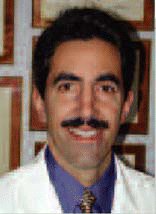The site of obstruction is critical for selecting an intervention. Use of CPAP or BIPAP with nasal prongs would be appropriate for someone with less severe nasal obstruction, he explained.
Explore This Issue
January 2007Identifying the site of obstruction in patients with sleep apnea is currently based on a thorough physical exam by an otolaryngologist. At the Lahey Clinic, CT scan of the sinuses is also performed, because we feel that many patients have a major nasal component to their sleep apnea, Dr. Catalano said.
The goal of intervention in obstructive sleep apnea is to restore normal physiology. Uvulopalatopharyngoplasty (UPPP) is an aggressive operation with high morbidity and suboptimal success rates, in Dr. Catalano’s view, and some patients cannot be cured with UPPP or any other surgical interventions. Therefore, the goal is not always cure but to restore a more physiologic CPAP pressure-for example, reducing CPAP pressure from 18, 16, or 14 to between 5 and 7, Dr. Catalano said.
A Better ‘Mousetrap’?
The ideal test for obstructive sleep apnea would identify the severity of the disorder and the sites of obstruction, and would be highly reproducible. Otolaryngologists in Europe have used an instrument that promises to be an improvement over PSG. Called an apneagraph, this instrument attempts to provide information on the degree of sleep apnea and identify the sites of obstruction by using a small pressure sensor places in the nose and going down the throat.
The European doctors I’ve spoken to say that this device is well tolerated and better tolerated than PSG. Also, reportedly, the test-to-test reliability is much greater, Dr. Catalano said. He noted that the apneagraph is a tool in development and said that probably more modifications will evolve. Even if we added it as a component of PSG, it could provide additive information, he said. He is currently trying to obtain an apneagraph from his European colleagues so that he can study it.
One of the biggest impediments in using PSG is that patients hate it and refuse to follow through on serial testing. In one multisite study reported at the recent AAO meeting, 50 percent of patients failed to complete post-treatment PSG testing, he said.
Drug-Induced Sleep Endoscopy
Preliminary research suggests that drug-induced sleep endoscopy (DISE) may be a useful diagnostic tool to guide surgical therapy and to understand why patents do not achieve desired outcomes after undergoing surgery, said Eric J. Kezirian, MD, Director of the Division of Sleep Surgery and Assistant Professor at University of California, San Francisco.

Leave a Reply